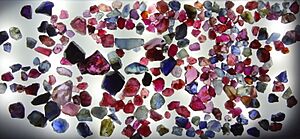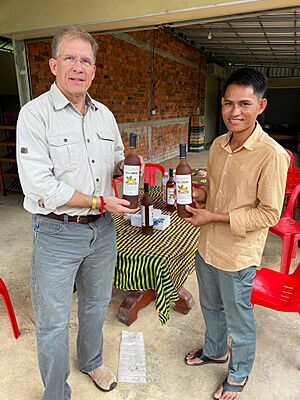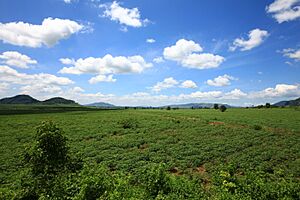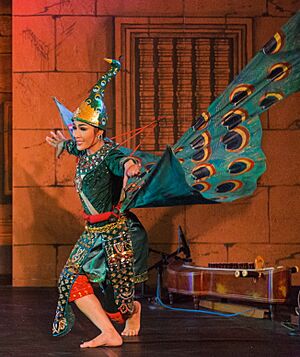Pailin province facts for kids
Quick facts for kids
Pailin
ប៉ៃលិន
|
||
|---|---|---|
| Pailin Province ខេត្តប៉ែលិន |
||

Pailin countryside from Phnom Yat
|
||
|
||

Map of Cambodia highlighting Pailin
|
||
| Country | ||
| Founded | 1909 | |
| City–municipality | 31 July 1997 | |
| Province | 22 December 2008 | |
| Capital | Pailin | |
| Subdivisions | 1 municipality; 1 district | |
| Area | ||
| • Total | 803 km2 (310 sq mi) | |
| Area rank | 23rd | |
| Population
(2023)
|
||
| • Total | ||
| • Rank | 24th | |
| • Density | 94/km2 (240/sq mi) | |
| • Density rank | 15th | |
| Time zone | UTC+07:00 (ICT) | |
| Dialing code | +855 | |
| ISO 3166 code | KH-24 | |
Pailin (Khmer: ប៉ៃលិន) is a province in western Cambodia. It sits at the northern edge of the Cardamom Mountains, close to the border with Thailand. The province is surrounded by Battambang province. Pailin became a separate area in 1996. This happened after a group of the Khmer Rouge gave up.
Pailin is famous for being a stronghold of the Khmer Rouge. They controlled it for a long time, even after being defeated in 1979. From 1994 to 1998, it was their capital. In Cambodia, Pailin is known for its natural treasures. These include beautiful gems and valuable timber.
Pailin was once part of the powerful Khmer Empire. In 1558, the Burmese took control. Later, the Siamese (Thai people) ruled it until 1907. It was also under Thai rule from 1941 to 1946 before returning to Cambodia. The Thai people called it "Phailin." Today, there is still a busy border crossing point in Pailin. In 2008, King Norodom Sihamoni made Pailin a province. He also changed some provincial borders.
Contents
Pailin's Past
Pailin City was an important trading center during the Khmer Empire. It continued to be a trade hub under French rule. French shops and farms were set up there. In the late 1800s, many people from Burma moved to the area. They became known as the Kula people. The Kula settled around Pailin. They built structures that looked like Burmese buildings.
Conflict in Cambodia
In the early 1970s, Pailin was a rich town. This was because of the many gems found nearby. It was one of the first cities the Khmer Rouge attacked. They began their big fight against the government of Khmer Republic. The city did not fight back. The Khmer Rouge soldiers were welcomed as heroes.
At this time, Prince Norodom Sihanouk had joined forces with the Khmer Rouge. Most people thought they were fighting to bring him back to power. But soon, most residents were forced to leave. They had to march to the countryside to work in rice fields. People thought to be linked to the government were killed.
The Khmer Rouge used money from mining in Pailin. This money helped them fund their fight. It also helped them run their government once they took over the country. When the People's Army of Vietnam pushed them out, they went back to Pailin. Many former Khmer Rouge leaders still live there today. Pailin was the capital of their special government.
After the Khmer Rouge
Some leaders hid because they feared being judged for their past actions. Others lived openly in the province. By 2007, the remaining Khmer Rouge leaders were being gathered. They were to face a special court. This included Khieu Samphan and Nuon Chea.
After the war, Pailin's economy struggled. Many local businesses failed. However, the area is now stable. It is seeing new tourism. People visit its old temples, natural forests, and wildlife. The precious gem market is also a big draw.
People of Pailin
The National Institute of Statistics of Cambodia collects information about people. In 2013, Pailin province had 65,792 people. This grew to 67,166 in 2014. In the latest count in 2019, the population was 71,600. Between 1998 and 2008, Pailin had the fastest population growth in Cambodia. But between 2008 and 2019, its growth slowed down.
Pailin's Economy
The area around Pailin was once full of different gemstones. These were mined almost completely to support the Khmer Rouge. They also cut down many trees, which caused a lot of environmental harm. Now, you can mostly find low-quality, cheap gems in the downtown Pailin market.
Traders in Pailin accept different types of money. These include Cambodian riels, US dollars, and Thai baht. US dollars are often preferred.
Farming in Pailin
Unlike most of Cambodia, Pailin has mostly high land. This means not much rice is grown there. It is hard for farmers to grow just enough food for themselves. When crops fail, people have to search for food. This can lead to more land mine accidents. Many farmers grow other crops for sale. These include sesame, mung beans, and soybeans. In 2003-04, Pailin produced 17,204 tons of maize. This was the second-highest amount in the country.
Longan Fruit Farming
Longans are an important crop in Pailin province. They are usually picked between August and December. The most common type grown is the Pailin longan. These are mainly farmed in Battambang, Banteay Meanchey, and Pailin provinces. In 2012, longan farms in Pailin covered about 425 hectares. They produced 1,000 tons of fruit. By 2024, this grew to almost 4,000 hectares.
In 2012, about 60% of Pailin longans were sold in Cambodia. The other 40% went to Thai buyers. From January to November 2022, farmers harvested 6,900 tonnes of longan. About 500 tonnes were sent to China. Longans were approved for direct export to China only since October 2022. After that, China's demand for Pailin longans grew. It became the biggest export market in early 2023.
Vouch Thuch (born 1983) is thought to be the first person to make longan wine in Cambodia. He runs the Pailin Longan Wine Handicraft business. He came to Pailin in 2000. He saw that longans did not have a good market. So, he started his longan wine business in 2008, called 'Palowin'. He also makes mango wine. In July 2022, the U.S. ambassador to Cambodia, W. Patrick Murphey, visited his winery.
Places to Visit
Wat Phnom Yat
This holy place was built by Shan migrants from Myanmar in 1922. It is in the center of Pailin. It has an old pagoda, similar to the Kola pagoda.
Wat Rattanak Sophoan
At the bottom of Phnom Yat is another pagoda, Wat Rattanak Sophoan. It is a Burmese-style pagoda, over 570 years old. On its walls, there is a carving. It shows the Hindu story of the churning of the Ocean of Milk.
Pailin's Culture
Pailin's culture is quite different from most of Khmer culture. Before the Khmer Rouge time, Pailin's culture was mostly Shan Burmese. It shares many things with the cultures of Thailand and Burma. You can see this in the food, clothes, temple designs, festivals, and arts.
The people of Pailin were mainly Kola. The Kola people first moved from Burma around 1876. (The Khmer people called Burmese people "Kola" or "Pumea"). Another group, the Shan, arrived from Burma in the 1920s. The "Kola" or Burmese immigrants in Pailin are known for working with precious gems. This is likely what brought them to Pailin. Pailin was known for its gems, just like the Mogok region in Burma. People in the gem business say Pailin's gems are like those from Mogok. So, Khmer people believed the Kola immigrants were from that region of Burma.
Several local languages are spoken, including Khmer, Shan, and Kola. The local Khmer language sounds a bit like Burmese, Kham Muang, and Mon language.
Local Food
Pailin has a few different kinds of food. Kola food is also special and different from Burmese food. The most popular Burmese-style dish is Kola noodles (មីកុឡា, mee kola). This is a vegetarian noodle dish. It is made with thin rice stick noodles. They are steamed and cooked with soy sauce and garlic chives. Sometimes, it has some meat and small lobster.
Other dishes include Tom yum from Thailand and Mon banana pudding from Burma. These foods have spread to other parts of Thailand and Cambodia. But usually, the versions elsewhere are sweeter than the ones in Pailin, especially in Phnom Penh.
Traditional Clothing
The traditional clothes of Pailin are called Longyi, also known as Sarong. This cloth is often sewn into a tube shape. It is worn around the waist and goes down to the feet. It stays in place by folding the fabric, without needing a knot. Sometimes, it is folded up to the knee to be more comfortable. These traditional "longyi" are about 2 meters long. The cloth is made of cotton and sometimes silk.
Kola men wear ankle-length "Longyi" with patterns like checks, plaids, or stripes in any color. Men always wear a white eingyi shirt. This shirt has a mandarin collar. Sometimes, they also wear a traditional jacket called taik-pon over their eingyi. It comes in white, gray, black, or terracotta colors. They wear a gaung baung turban on their head. On their feet, they wear simple rubber or velvet slippers.
For Kola women, their calf-length longyi are in solid colors, flower prints, and many designs. They often have a red base color, with some stripes or very small checks. This is similar to what Mon women wear. They also often have horizontal or vertical stripes in the middle. Royal women traditionally wore a long dress called "thin-dai." It was decorated with many threads. Only a lord's daughter or the king's lady would wear it.
Women wear a beautiful blouse and a lovely shirt called eingyi. The shirt is decorated with several colors and silver pieces. It also has horizontal or vertical stripes in the middle. Kola women tie a traditional shawl on their eingyi or put it on their shoulders. Women tie a lovely band on their head and wear pretty flowers in their hair. They let their hair fall as a ponytail above their shoulders. Sometimes, they carry a traditional umbrella made from bamboo. Their footwear is simple slippers of leather or velvet called Hnyat-phanat.
All these costumes were bright and shiny during celebrations. The clothing is very similar to what the Shan people wear in Burma.
Houses in Pailin are built from wood. They have a wide door, about 8 cm to 1 meter wide. In the middle of the house, there are small shrines for Buddha and other spirits. The Kola people love to plant roses in front of their homes.
Land Mines
Pailin and Cambodia had many land mines planted during three decades of war. There are still many land mines and unexploded bombs. People are warned to stay on marked roads. Teams are working to remove these mines with help from the UN. This work brings some of the few foreigners that locals meet.
Notable People
- Rady Mom, a US state representative in Massachusetts.
See also
 In Spanish: Provincia de Pailín para niños
In Spanish: Provincia de Pailín para niños






